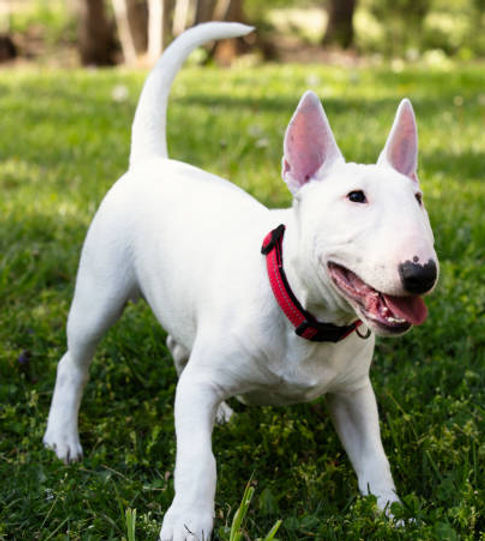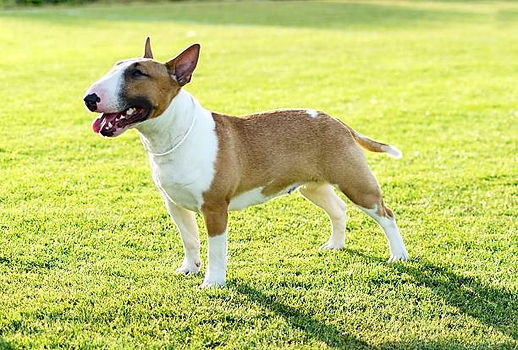Stellar Bulldogs

Welcome to Stellar Bulldogs information site and bulldog community.

Bull Terrier
Ever wonder what it's like to have a living cartoon character as a pet? Meet the bull terrier - With their egg-shaped heads and mischievous grins, these dogs are walking conversation starters. But don't let their comical appearance fool you; bull terriers are loyal, energetic, and full of personality. They're the clowns of the canine world, always ready to entertain with their playful antics and unwavering devotion.
Bull Terriers are known for their distinctive "egg-shaped" heads, muscular build, and playful, energetic personalities. They are intelligent and can be fiercely loyal to their families, but also have a stubborn streak, requiring consistent training and socialization from a young age. Their history as fighting dogs contributes to their protective nature, making early socialization with other animals and people crucial. Bull Terriers are often described as clowns due to their goofy antics and love of play. Their playful, energetic personalities, plus their loyalty and affectionate nature towards their families, making them great companions. Despite their tough appearance, Bull Terriers are typically friendly and can be quite silly, displaying a strong sense of humor. They require regular exercise and mental stimulation, as they are intelligent and can be prone to boredom.
The bull terrier was developed in the 19th century, England and was a cross between a bulldog and now extinct white English terrier, by a Englishman James Hicks. The cross-pollination of these two kinds of dogs resulted in what they called, the bull and terrier. These crossbreeds, also termed half-and-halfs and half-breds, provided their breeders with the best of both worlds.
They had the tenacity and gripping power of the bulldog and the gameness and agility of the terrier. Like any good cook, Hinks added a dash of this and a pinch of that to make the standard bull-and-terrier formula his own. While as a rule, these pragmatic, working-class dog dealers didn’t document their improvisations, Hinks’ son – also named James – noted that his father used Dalmatians early on to impart the Bull Terrier’s striking all-white coat.

Hinks concentrated on streamlining his dogs while retaining their density of form, and lost some of their bulliness, the dogs then became more refined. They had longer fore faces and necks, with less wrinkling and lippiness. Many breeders began to breed bulldogs with terriers, arguing that such a mixture enhances the quality of fighting. Despite the fact that a cross between a bulldog and a terrier was of high value, very little or nothing was done to preserve the breed in its original form.
With all of his rough edges smoothed down without being softened; alert, active, plucky, muscular, and a real gentleman,” recalled Hinks’ son James. “Naturally, this change brought the Bull Terrier many admirers.” The American Kennel Club (AKC) recognized the breed in 1885, giving this breed a long lineage of history. Read More >
White Bull Terrier Adult
History Of The Bull Terrier
Hinks wanted his dogs white, and bred specifically for this. The first modern Bull Terrier is now recognized as "Lord Gladiator", from 1917.
Due to medical problems associated with all-white breeding, Ted Lyon among others began introducing color, using Staffordshire Bull Terriers in the early 20th century. Colored Bull Terriers were recognized as a separate variety (at least by the AKC) in 1936.
Keep The Fun Coming...
Bull Terriers are intelligent and energetic dogs that thrive on mental stimulation. Engaging them with puzzle toys, training exercises, and interactive games like hide and seek with treats encourages their problem-solving skills and keeps them entertained.
Regular mental challenges not only prevent boredom but also contribute to their overall well-being, helping to channel their energy positively. Bull terriers thrive on physical and mental stimulation, making outdoor activities like frisbee and river play ideal for keeping them engaged. These activities not only provide the necessary exercise but also strengthen the bond between you and your dog, encouraging teamwork and obedience while allowing them to explore and enjoy their environment. Regularly incorporating such challenges into their routine can help prevent boredom and associated behavioral issues.
Physical Characteristics
The Bull Terrier has a long, oval head with a flat top, giving it a unique egg-like shape. Its eyes are small, dark, and triangular, contributing to its alert and intelligent expression.
Their body is solidly built with a muscular body, showcasing strength and agility. It has a short, smooth coat that is easy to maintain and come in a large variation of colors.
They generally weigh between 50 to 70 pounds and stand about 21 to 22 inches tall at the shoulder.

Adult Female Bull Terrier
Temperament
Bull Terriers are known for their playful and mischievous nature. They are highly energetic and require plenty of exercise to keep them happy and healthy. Some key personality traits of Bull Terriers are known to be very affectionate with their family members, they love attention and are often described as "clowns" due to their playful antics, they can also be quite stubborn, so consistent training and firm, gentle guidance are essential. While Bull Terriers are generally friendly, they are also protective of their loved ones and can be wary of strangers. AKC has them "not recommended with other dogs" category.
A Bull Terrier has an even temperament and is amenable to discipline, the breed is described by the Bull Terrier Club as particularly good with people. Early socialization will ensure that the dog will get along with other dogs and animals.Their personality is described as courageous, full of spirit, with a fun-loving attitude.
Health Issues

Bull Terriers can be prone to several health issues including skin problems, particularly allergies and dermatitis, heart conditions like dilated cardiomyopathy, and kidney diseases such as nephritis. They may also experience issues related to their unique head shape, including deafness and certain eye conditions. Regular veterinary check-ups and a proper diet can help mitigate some of these risks.
Bull Terriers are generally healthy but can be prone to certain health issues. It's important to be aware of the following:
-
Deafness: This breed can be susceptible to congenital deafness, especially in white Bull Terriers.
-
Skin Allergies: They may experience skin issues or allergies, requiring attention to their diet and environment. Read home allergy relief tips >
-
Obesity: Due to their love for food, monitoring their diet and ensuring adequate exercise is crucial to prevent obesity. Terriers from good breeders who health-test usually become healthy, happy, family members.
-
Hereditary Nephritis (Kidney Disease): This can lead to kidney failure, and early detection through urine screening is crucial.
-
Lethal acrodermatitis, also known as Acrodermatitis of the Bull Terrier is a rare genodermatosis monogenic autosomal inherited disease found exclusively in white Bull Terriers (including the miniature Bull Terrier). The condition is usually fatal and is characterised by poor growth, decreased serum copper and zinc levels, and immunodeficiency.
On Your Mark - Get Set - Go!
Get ready for a whirlwind of energy and antics with a bull terrier by your side! These clownish canines are always up for a good time, bouncing around with seemingly endless enthusiasm. One minute they're chasing their tail in circles, the next they're bringing you their favorite toy for an important game of tug-of-war.
With their muscular build and determined spirit, bull terriers have a zest for life that's downright contagious.
They are the ultimate workout buddies and entertainment wrapped up in an adorable package. So if you're looking for a four-legged friend to inject some extra pep and playfulness into your daily routine, look no further than the irresistibly charming bull terrier!
Always know the breeder when shopping for your next best friend Read Why >